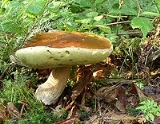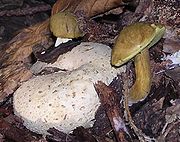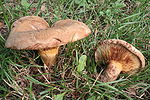
Boletales
Encyclopedia
The Boletales are an order of Agaricomycetes
, containing over 1300 species with a diverse array of fruiting body types. The boletes are the best known members of this group, and until recently, the Boletales were thought to only contain boletes. The Boletales are now known to contain distinct groups of agarics, gasteromycetes, and other fruiting body types.
and Paxillaceae
, which often have the same flesh texture as the Boletes, spore-bearing tissue which is also easily separable from the cap, and similar microscopic characteristics of spores and cystidia. Molecular phlyogenetic
evidence has moved several other physically dissimilar groups into Boletales, including the Sclerodermataceae
(earthballs) and the Rhizopogonaceae
(false truffles).
Phylogenetic analyses shows the Sclerodermataceae
, Boletinellaceae
and Gyroporaceae appear to form a discrete group within the Boletales, and together with the Pisolithaceae, the Astraceae and the Calostomaceae, are grouped under the suborder Sclerodermatineae. Thus the boletes of Gyrodon
and Phlebopus
are more closely related to earthballs
of Scleroderma
than to Boletus
. Similarly, the bolete genus Suillus
is more closely related to the agarics and false truffles of Chroogomphus
, Gomphidius
, and Rhizopogon
than to Boletus.
In some classification systems, a part of the family Boletaceae
is separated off to form the family Strobilomycetaceae
. According to the 2008 (10th) edition of the Dictionary of the Fungi, the Boletales comprise 17 families
, 96 genera
, and 1316 species
.
 The Boletales are largely ectomycorrhizal fungi, and hence are found mainly in or near woodlands. Certain species are parasitic rather than ectomycorrhizal. Members of the family Gomphidiaceae
The Boletales are largely ectomycorrhizal fungi, and hence are found mainly in or near woodlands. Certain species are parasitic rather than ectomycorrhizal. Members of the family Gomphidiaceae
are thought to be parasitic upon members of the family Suillaceae
; these relationships are often highly species-specific. Other parasitic boletes included Boletus parasiticus
which grows on Scleroderma citrinum
.
 Boletes are usually identified by having a sponge-like surface under the cap, instead of the usual gills. They come in a variety of colours such as Red, White, Brown and Grey. Many of the inedible boletes are either white or red, and these should be avoided during picking.
Boletes are usually identified by having a sponge-like surface under the cap, instead of the usual gills. They come in a variety of colours such as Red, White, Brown and Grey. Many of the inedible boletes are either white or red, and these should be avoided during picking.
The genus Boletus contains many members which are edible and tasty, most notably, the Boletus edulis
(Porcini) group, including Boletus aereus
and Boletus pinophilus, though many others are eaten as well, such as Boletus badius
. Boletus edulis and its relatives are of great commercial importance in Europe and North America. Species of Suillus
are considered by many to be slimy and insipid, however, in Russia, they are often pickled and even sold commercially this way. In North America, Suillus pungens is known also as the "Slippery Jack," and said by some to be delicious cooked, provided the slimy coat of its cap is removed beforehand.
Many boletes, while non-toxic, are nonetheless bitter tasting and inedible.
The Paxillaceae
contain a number of species that have been implicated in fatal poisonings. A few boletes are also highly toxic (though generally not deadly), notably the (fortunately fairly conspicuous) Boletus satanas and allies. Still, many mushroom hunters
recommend that beginners start with boletes, since deadly mix-ups are far less likely than with agarics.
Agaricomycetes
Agaricomycetes is a class of fungi. The taxon is roughly identical to that defined for the Homobasidiomycetes by Hibbett & Thorn, with the inclusion of Auriculariales and Sebacinales. It includes not only mushrooms but also most species placed in the deprecated taxa Gasteromycetes and...
, containing over 1300 species with a diverse array of fruiting body types. The boletes are the best known members of this group, and until recently, the Boletales were thought to only contain boletes. The Boletales are now known to contain distinct groups of agarics, gasteromycetes, and other fruiting body types.
Taxonomy
The order Boletales originally was erected to describe boletes, however, based on micromorphological and molecular phylogenetic characteristics, it has recently been established that a large number of non-bolete species belong to this group as well. The order also includes some gilled mushrooms, in the families GomphidiaceaeGomphidiaceae
Gomphidiaceae are a family of mushrooms in Boletales or pored fungi. Unlike other boletes, all members of Gomphidiaceae are agarics, having gills instead of pores. Member genera include Chroogomphus, Cystogomphus, Gomphidius and Gomphogaster, the last being a monotypic genus Gomphidiaceae are a...
and Paxillaceae
Paxillaceae
The Paxillaceae are a family of mushrooms bearing close affinity to the Boletes. Collectively, the family contains nine genera and 78 species. The type genus is Paxillus, containing fungi with decurrent gills, and Gyrodon, which has members with decurrent pores, among others...
, which often have the same flesh texture as the Boletes, spore-bearing tissue which is also easily separable from the cap, and similar microscopic characteristics of spores and cystidia. Molecular phlyogenetic
Molecular phylogeny
Molecular phylogenetics is the analysis of hereditary molecular differences, mainly in DNA sequences, to gain information on an organism's evolutionary relationships. The result of a molecular phylogenetic analysis is expressed in a phylogenetic tree...
evidence has moved several other physically dissimilar groups into Boletales, including the Sclerodermataceae
Sclerodermataceae
The Sclerodermataceae are a family of fungi in the order Boletales, containing several genera of unusual fungi that little resemble boletes. Taxa, which include species commonly known as the ‘hard-skinned puffballs’, ‘earthballs’, or 'earthstars', are widespread in both temperate and tropical regions...
(earthballs) and the Rhizopogonaceae
Rhizopogonaceae
Rhizopogonaceae are a family of fungi in the order Boletales. The family, first named and described by botanists Ernst Albert Gäumann and Carroll William Dodge in 1928, contains 3 genera and 152 species....
(false truffles).
Phylogenetic analyses shows the Sclerodermataceae
Sclerodermataceae
The Sclerodermataceae are a family of fungi in the order Boletales, containing several genera of unusual fungi that little resemble boletes. Taxa, which include species commonly known as the ‘hard-skinned puffballs’, ‘earthballs’, or 'earthstars', are widespread in both temperate and tropical regions...
, Boletinellaceae
Boletinellaceae
Boletinellaceae are a small family of mushrooms, primarily characterized by small pores on the underside of the mushroom rather than gills. Though in the order Boletales, new research shows they and Gyroporaceae are more closely related to earthballs of Sclerodermataceae than Boletaceae.Genera...
and Gyroporaceae appear to form a discrete group within the Boletales, and together with the Pisolithaceae, the Astraceae and the Calostomaceae, are grouped under the suborder Sclerodermatineae. Thus the boletes of Gyrodon
Gyrodon
Gyrodon is a genus of pored mushroom bearing close affinity to the genus Paxillus. Recent molecular research has confirmed this relationship of the two genera as sister groups, together lying near the base of a phylogenetic tree from which the genus Boletus arises.Species include Gyrodon lividus of...
and Phlebopus
Phlebopus
Phlebopus is a genus of fungi in the family Boletinellaceae . The genus has a widespread distribution in subtropical and pantropical regions, and contains 12 species. The species are saprobic, with some possibly able to form mycorrhizae with exotic trees in certain conditions...
are more closely related to earthballs
Scleroderma citrinum
Scleroderma citrinum, commonly known as the common earthball, pigskin poison puffball, or common earth ball, is the most common species of earthball in the UK and occurs widely in woods, heathland and in short grass from Autumn to Winter.Scleroderma citrinum has two synonyms, Scleroderma aurantium ...
of Scleroderma
Scleroderma (genus)
Scleroderma is a genus of fungi, commonly known as earth balls, now known to belong to the Boletales order, in suborder Sclerodermatineae.. The best known species are S. citrinum and S. verrucosum...
than to Boletus
Boletus
Boletus is a genus of mushroom, comprising over 100 species. The genus Boletus was originally broadly defined and described by Elias Magnus Fries in 1821, essentially containing all fungi with pores...
. Similarly, the bolete genus Suillus
Suillus
Suillus is a genus of basidiomycete fungi in the family Suillaceae and order Boletales. Species in the genus are associated with coniferous trees, and are mostly distributed in northern temperate locations, although some species have been introduced to the Southern Hemisphere.-Taxonomy:The genus...
is more closely related to the agarics and false truffles of Chroogomphus
Chroogomphus
Chroogomphus is a genus of mushrooms commonly known as pine-spikes or spike-caps based on their shape and the fact that they are always found growing in association with pine trees...
, Gomphidius
Gomphidius
Gomphidius is a genus of mushrooms, commonly known as spike-caps, that are members of the Boletales , or pored fungi. They appear to have gill-like structures which resemble those of agarics, however the similarity is superficial only. The best-known member is the slimy spike-cap...
, and Rhizopogon
Rhizopogon
Rhizopogon is a genus of hypogeous Basidiomycetes. Recent micromorphological and molecular phylogenetic study has established that Rhizopogon is a member of the Boletales, closely related to Suillus. All species of Rhizopogon are ectomycorrhizal and are thought to play an important role in the...
than to Boletus.
In some classification systems, a part of the family Boletaceae
Boletaceae
Boletaceae are a family of mushrooms, primarily characterized by developing their spores in small pores on the underside of the mushroom, instead of gills, as are found in agarics. Nearly as widely distributed as agarics, they include the Cep or King Bolete , much sought after by mushroom hunters...
is separated off to form the family Strobilomycetaceae
Strobilomycetaceae
Strobilomycetaceae is a family of fleshy pore-bearing fungi in the order Boletales, first defined by E. J. Gilbert in 1931.However it is not recognized in all systems of classification; those authorities which do not regard this group of mushrooms as a separate family assign them to the...
. According to the 2008 (10th) edition of the Dictionary of the Fungi, the Boletales comprise 17 families
Family (biology)
In biological classification, family is* a taxonomic rank. Other well-known ranks are life, domain, kingdom, phylum, class, order, genus, and species, with family fitting between order and genus. As for the other well-known ranks, there is the option of an immediately lower rank, indicated by the...
, 96 genera
Genus
In biology, a genus is a low-level taxonomic rank used in the biological classification of living and fossil organisms, which is an example of definition by genus and differentia...
, and 1316 species
Species
In biology, a species is one of the basic units of biological classification and a taxonomic rank. A species is often defined as a group of organisms capable of interbreeding and producing fertile offspring. While in many cases this definition is adequate, more precise or differing measures are...
.
Ecology

Gomphidiaceae
Gomphidiaceae are a family of mushrooms in Boletales or pored fungi. Unlike other boletes, all members of Gomphidiaceae are agarics, having gills instead of pores. Member genera include Chroogomphus, Cystogomphus, Gomphidius and Gomphogaster, the last being a monotypic genus Gomphidiaceae are a...
are thought to be parasitic upon members of the family Suillaceae
Suillaceae
The Suillaceae are a family of fungi in the order Boletales , containing the boletus-like Suillus, the small truffle-like Truncocolumella, as well as the monotypic genus Psiloboletinus. As of 2008, there are 54 species in the family...
; these relationships are often highly species-specific. Other parasitic boletes included Boletus parasiticus
Boletus parasiticus
Boletus parasiticus, or Pseudoboletus parasiticus, commonly known as the Parasitic Bolete is a rare, inedible Boletus mushroom found on decaying earthballs .-Description:...
which grows on Scleroderma citrinum
Scleroderma citrinum
Scleroderma citrinum, commonly known as the common earthball, pigskin poison puffball, or common earth ball, is the most common species of earthball in the UK and occurs widely in woods, heathland and in short grass from Autumn to Winter.Scleroderma citrinum has two synonyms, Scleroderma aurantium ...
.
Edibility and Identification

The genus Boletus contains many members which are edible and tasty, most notably, the Boletus edulis
Boletus edulis
Boletus edulis, commonly known as penny bun, porcino or cep, is a basidiomycete fungus, and the type species of the genus Boletus. Widely distributed in the Northern Hemisphere across Europe, Asia, and North America, it does not occur naturally in the Southern Hemisphere, although it has been...
(Porcini) group, including Boletus aereus
Boletus aereus
Boletus aereus is a bolete, an edible mushroom frequently consumed in the Basque Country, Navarre, France and Italy. It is commonly known as ontto beltza in Basque, porcino nero in Italian, and tête de nègre in French...
and Boletus pinophilus, though many others are eaten as well, such as Boletus badius
Boletus badius
Boletus badius , and commonly known as the Bay Bolete is an edible, pored mushroom from Europe and North America...
. Boletus edulis and its relatives are of great commercial importance in Europe and North America. Species of Suillus
Suillus
Suillus is a genus of basidiomycete fungi in the family Suillaceae and order Boletales. Species in the genus are associated with coniferous trees, and are mostly distributed in northern temperate locations, although some species have been introduced to the Southern Hemisphere.-Taxonomy:The genus...
are considered by many to be slimy and insipid, however, in Russia, they are often pickled and even sold commercially this way. In North America, Suillus pungens is known also as the "Slippery Jack," and said by some to be delicious cooked, provided the slimy coat of its cap is removed beforehand.
Many boletes, while non-toxic, are nonetheless bitter tasting and inedible.
The Paxillaceae
Paxillaceae
The Paxillaceae are a family of mushrooms bearing close affinity to the Boletes. Collectively, the family contains nine genera and 78 species. The type genus is Paxillus, containing fungi with decurrent gills, and Gyrodon, which has members with decurrent pores, among others...
contain a number of species that have been implicated in fatal poisonings. A few boletes are also highly toxic (though generally not deadly), notably the (fortunately fairly conspicuous) Boletus satanas and allies. Still, many mushroom hunters
Mushroom hunting
Mushroom hunting, mushrooming, mushroom picking, and similar terms describe the activity of gathering mushrooms in the wild, typically for eating...
recommend that beginners start with boletes, since deadly mix-ups are far less likely than with agarics.
External links
- "The Boletes ('Boletales')" by Michael Kuo, MushroomExpert.Com, March 2005
- The Boletes of Michigan by Alexander H. Smith and Harry D. Thiers, 1971. (Full text monograph)

